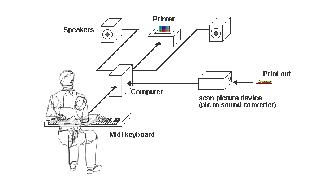


| URL: | http://netzspannung.org/database/103110/de |
| Last update: | 03.07.2003 |
| Date of print: |
 |
Illustration of installation setup |
Kurzdarstellung
Kurzbeschreibung
Für das Aufzeichnen, Abspielen und Speichern von Musik gibt es eine Vielzahl von Medien wie CDs, Bänder, DAT und Mini Disc. Bei diesen Medien handelt es sich zweifellos um sehr populäre Standardformate, die für hochwertige Musikqualität stehen. Allerdings können diese Medien ohne Cover und Booklets keine visuellen Inhalte oder Ästhetik vermitteln. Aus diesem Grund haben wir uns entschlossen, ein neues Medium für Musik zu entwickeln, das aus sehr einfachem und billigem Material gefertigt wird und das nicht nur zum Speichern oder Abspielen von Musik, sondern auch zum Aufzeichnen und Komponieren mit visueller Ästhetik geeignet ist.
KünstlerInnen / AutorInnen
- Tang Ching Hei
MitarbeiterInnen
- Lo Chin Cheung
- Lim Han Kyu
Entstehung
Vereinigtes Königreich, 2003-2004
Eingabe des Beitrags
Chin Cheung Lo, 03.07.2003
Kategorie
- künstlerische Arbeit
Schlagworte
- Themen:
- Mixed Reality |
- Musik |
- Audio |
- Medienkunst |
- Klang
- Formate:
- Installation |
- Audio
- Technik:
- Midi
Ergänzungen zur Schlagwortliste
- Color Tracking |
- MAX/MSP
Kontext
Hochschule / Fachbereich
Ravensbourne College of Design and Communication
MA Interactive Digital Media
URL der Hochschule
» http://www.rave.ac.uk
Betreuer des Projekts
Prof. Karel Dudesek
Kommentar des Betreuers
The Pixel Orchestra is a three way input output sound generative project:
Not only that the sound piece
1st is stored on a colour printed paper but as well the system can interact with
2nd a scanned image and play the image like a CD or other storage media
3rd the user can draw pixels by hand on a paper sheet, by scanning in the image the computer translates it into sound.
Seminar / Kurzbeschreibung
MA Interactive Digital Media at Ravensbourne College, London, is a relatively new course, since 1 year led by Professor Karel Dudesek of Vienna, who brings experience on a wide range of activities from media arts to interactive television to virtual reality. The intention is to offer a much broader horizon for students than that of typical "multimedia courses".
The students & staff of MA IDM are involved with creating projects in interactivity, visual and audio mediums, online and networked systems and generally exploring new approaches to technology. This has been realized through the ongoing development of an MA Experimental Resource -<XR>- a studio with a philosophy to develop "space based media", both actual and virtual. What we are developing is a resource for spatial sound installation, a virtual set area, use of tracking and interactive sensing equipment, all linked to computers and software such as Max, MSP, Nato. We are inviting students to use sensors and electronics to make real-time interaction, and to think about presenting their work in a different way. In the first year it has been the introduction of Max software into the curriculum that has kick-started this progression to a new kind of work, and the creation of some exciting projects.
Zuordnung Forschungsbereich
In the current second year, students have realised projects with spatial interaction and sound, using techniques such as video tracking and surround sound positioning. The current interest both from staff and students are works that reflect upon the experience of time based, or real-time art works, and that uses processes available in the software such as Max/MSP/Jitter to make prototypes and presentations of these ideas. Time is certainly a key part of media art installations. Viewers are familiar with works that are immersive, whether by use of VR equipment or large scale projection, and are seemingly looking for works that allow themselves to be immersed in the technology. What is interested in using software that can work in real-time and interactively, is that the "time" element of the work can be played with and thus we have ideas such as the memory recorder. Previous projects and works in progress are showcased on the website at: http://www.ma.rave.ac.uk/xr/
|
|
| » http://www.ma.rave.ac.uk/pixelorchestra |
|
|